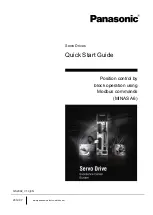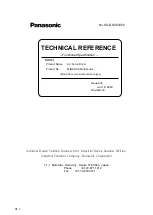
Parameter
Function
8-36 Maximum
Response Delay
Specify a maximum delay time between
transmitting a request and receiving a
response.
8-37 Maximum
Inter-char delay
If transmission is interrupted, specify a
maximum delay time between two received
bytes to ensure time-out.
Table 3.2 Modbus Communication Parameter Settings
3.1.5 EMC Precautions
To achieve interference-free operation of the RS-485
network, Danfoss recommends the following EMC
precautions.
NOTE
Observe relevant national and local regulations, for
example regarding protective earth connection. To avoid
coupling of high-frequency noise between the cables, the
RS-485 communication cable must be kept away from
motor and brake resistor cables. Normally, a distance of
200 mm (8 inches) is sufficient, but Danfoss recommends
keeping the greatest possible distance between the cables.
Especially where cables run in parallel over long distances.
When crossing is unavoidable, the RS-485 cable must cross
motor and brake resistor cables at an angle of 90
°
.
3.2 FC Protocol Overview
The FC protocol, also referred to as FC bus or Standard
bus, is the Danfoss standard fieldbus. It defines an access
technique according to the master-slave principle for
communications via a serial bus.
One master and a maximum of 126 slaves can be
connected to the bus. The master selects the individual
slaves via an address character in the telegram. A slave
itself can never transmit without first being requested to
do so, and direct message transfer between the individual
slaves is not possible. Communications occur in the half-
duplex mode.
The master function cannot be transferred to another node
(single-master system).
The physical layer is RS-485, thus utilizing the RS-485 port
built into the frequency converter. The FC protocol
supports different telegram formats:
•
A short format of 8 bytes for process data.
•
A long format of 16 bytes that also includes a
parameter channel.
•
A format used for texts.
3.2.1 FC with Modbus RTU
The FC protocol provides access to the Control Word and
Bus Reference of the frequency converter.
The Control Word allows the Modbus master to control
several important functions of the frequency converter.
•
Start
•
Stop of the frequency converter in various ways:
•
Coast stop
•
Quick stop
•
DC Brake stop
•
Normal (ramp) stop
•
Reset after a fault trip
•
Run at various preset speeds
•
Run in reverse
•
Change of the active set-up
•
Control of the 2 relays built into the frequency
converter
The bus reference is commonly used for speed control. It is
also possible to access the parameters, read their values,
and where possible, write values to them. This permits a
range of control options, including controlling the setpoint
of the frequency converter when its internal PI controller is
used.
3.3 Network Configuration
3.3.1 Frequency Converter Set-up
Set the following parameters to enable the FC protocol for
the frequency converter.
Parameter
Setting
8-30 Protocol
FC
8-31 Address
1-126
8-32 Baud Rate
2400-115200
8-33 Parity / Stop Bits
Even parity, 1 stop bit (default)
Table 3.3 Network Configuration Parameters
3.4 FC Protocol Message Framing Structure
3.4.1 Content of a Character (byte)
Each character transferred begins with a start bit. Then 8
data bits are transferred, corresponding to a byte. Each
character is secured via a parity bit. This bit is set at "1"
when it reaches parity. Parity is when there is an equal
number of 1s in the 8 data bits and the parity bit in total.
RS-485 Installation and Set...
VLT
®
AutomationDrive FC 360 Design Guide
42
MG06B202 - VLT
®
is a registered Danfoss trademark
3
3
















































